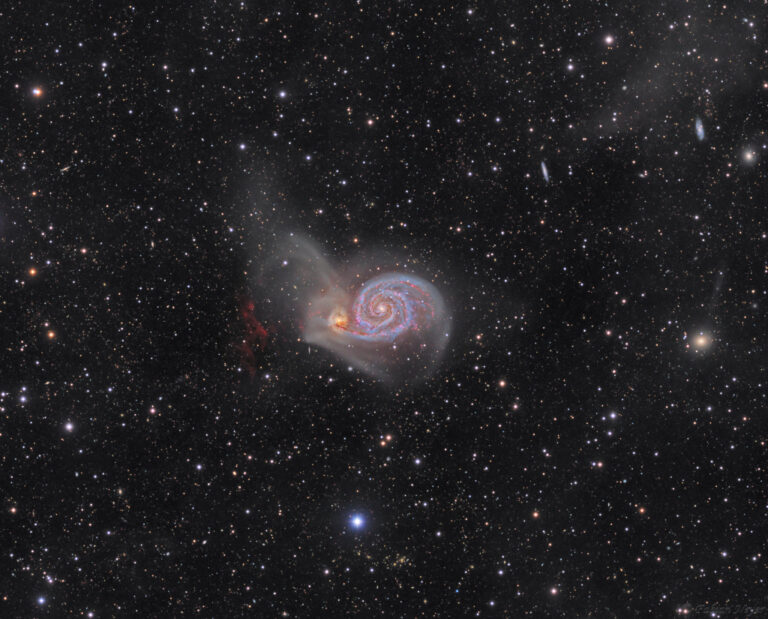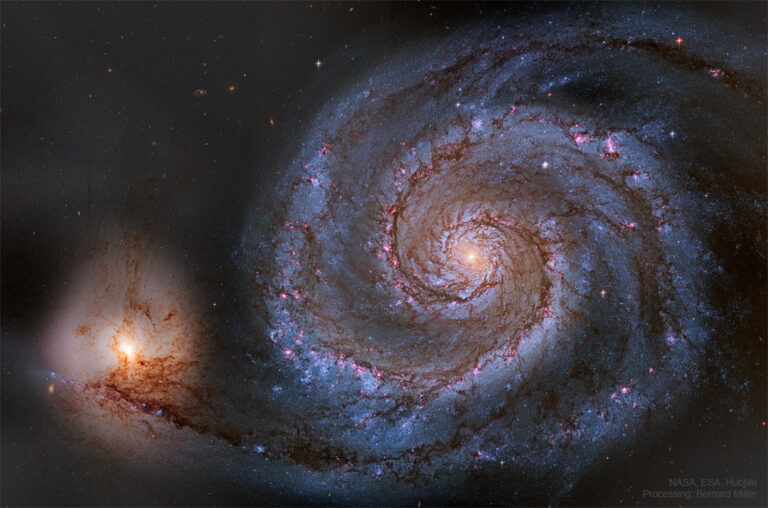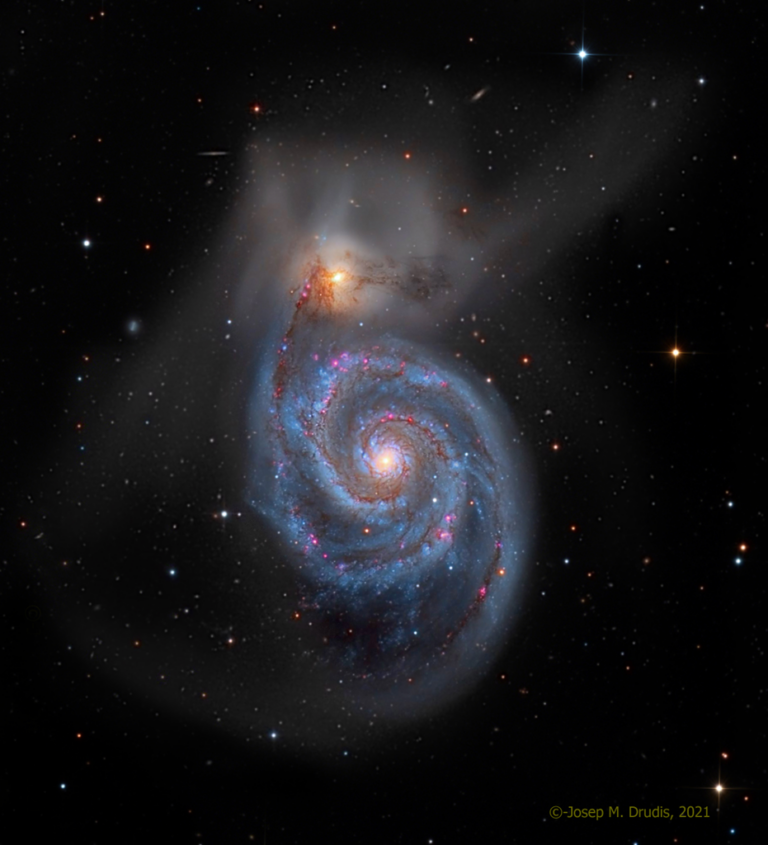M51: 潮汐流与氢α峭壁
See Explanation. Clicking on the picture will download the highest resolution version available.
请参阅说明。单击图片将下载可用的最高分辨率版本。

See Explanation. Clicking on the picture will download the highest resolution version available.
请参阅说明。单击图片将下载可用的最高分辨率版本。

2023年8月11日 Messier 51 in 255 Hours Image Credit & Copyright: The Deep Sky Collective – Carl Björk, Thomas Bähnck, Sebastian Donoso, Jake Gentillon, Antoine and Dalia Grelin, Stephen Guberski, Richard Hall, Tino Heuberger, Jason Jacks, Paul Kent, Brian Meyers, William Ostling, Nicolas Puig, Tim Schaeffer, Felix Schöfbänker, Mikhail Vasilev Explanation: An intriguing pair of interacting galaxies, M51 is the 51st entry in Charles Messier’s famous catalog. Perhaps the original spiral nebula, the large galaxy with whirlpool-like spiral structure seen nearly face-on is also cataloged as NGC 5194. Its spiral arms and dust lanes sweep in front of a companion galaxy (right), NGC 5195. Some 31 million light-years distant, within the boundaries of the well-trained constellation Canes Venatici, M51 looks faint and fuzzy to the eye…

2022年9月2日 M51: The Whirlpool Galaxy Image Credit & Copyright: Fabian Neyer Explanation: Find the Big Dipper and follow the handle away from the dipper’s bowl until you get to the last bright star. Then, just slide your telescope a little south and west and you’ll come upon this stunning pair of interacting galaxies, the 51st entry in Charles Messier’s famous catalog. Perhaps the original spiral nebula, the large galaxy with well defined spiral structure is also cataloged as NGC 5194. Its spiral arms and dust lanes clearly sweep in front of its companion galaxy (left), NGC 5195. The pair are about 31 million light-years distant and officially lie within the angular boundaries of the small constellation Canes Venatici. In direct telescopic views, M51 looks faint…

2022年6月13日 M51: The Whirlpool Galaxy from Hubble Image Credit: NASA, ESA, Hubble, HLA; Processing & Copyright: Bernard Miller Explanation: The Whirlpool Galaxy is a classic spiral galaxy. At only 30 million light years distant and fully 60 thousand light years across, M51, also known as NGC 5194, is one of the brightest and most picturesque galaxies on the sky. The featured image is a digital combination of images taken in different colors by the Earth-orbiting Hubble Space Telescope, highlighting many sharp features. Anyone with a good pair of binoculars, however, can see this Whirlpool toward the constellation of the Hunting Dogs (Canes Venatici). M51 is a spiral galaxy of type Sc and is the dominant member of a whole group of galaxies. Astronomers speculate that…

2021年9月2日 M51: The Whirlpool Galaxy Image Credit & Copyright: Josep Drudis Explanation: Find the Big Dipper and follow the handle away from the dipper’s bowl until you get to the last bright star. Then, just slide your telescope a little south and west and you’ll come upon this stunning pair of interacting galaxies, the 51st entry in Charles Messier’s famous catalog. Perhaps the original spiral nebula, the large galaxy with well defined spiral structure is also cataloged as NGC 5194. Its spiral arms and dust lanes clearly sweep in front of its companion galaxy (top), NGC 5195. The pair are about 31 million light-years distant and officially lie within the angular boundaries of the small constellation Canes Venatici. Though M51 looks faint and fuzzy to…

2021年01月20日 The Magnetic Field of the Whirlpool Galaxy Image Credit: NASA, SOFIA, HAWC+, Alejandro S. Borlaff; JPL-Caltech, ESA, Hubble; Text: Jayanne English (U. Manitoba) Explanation: Do magnetic fields always flow along spiral arms? Our face-on view of the Whirlpool Galaxy (M51) allows a spectacularly clear view of the spiral wave pattern in a disk-shaped galaxy. When observed with a radio telescope, the magnetic field appears to trace the arms’ curvature. However, with NASA’s flying Stratospheric Observatory for Infrared Astronomy (SOFIA) observatory, the magnetic field at the outer edge of M51’s disk appears to weave across the arms instead. Magnetic fields are inferred by grains of dust aligning in one direction and acting like polaroid glasses on infrared light. In the featured image, the field orientations…